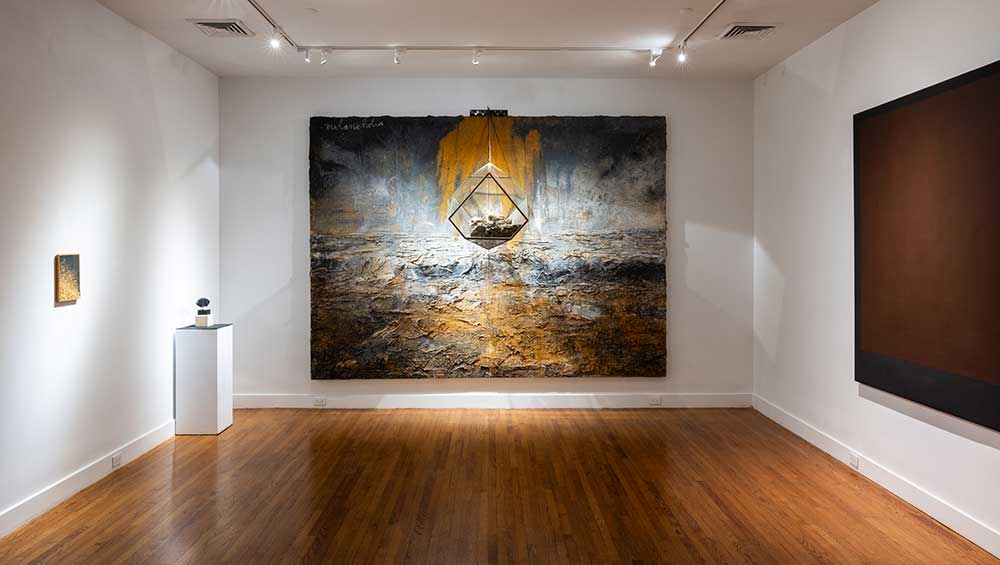
Centre: Anselm Kiefer, Melancholia, 2005. Installation view, Expansive Change: Distortion as Dialogue in Modern & Contemporary Art, Leila Heller Gallery, New York, 2024. Photo: David Kaminsky.
Leila Heller Gallery, New York
4 May – 30 August 2024
by LILLY WEI
Expansive Change: Distortion as Dialogue in Modern & Contemporary Art is the theme of the exhibition now on view at the Leila Heller Gallery in New York, curated by Santiago Rumney-Guggenheim. Emphasising the word “distortion”, Rumney-Guggenheim says it is what has largely “shaped modern and contemporary art”, its unexpected twists and shifts serving as a “powerful narrative tool”. Into the slipstream of this capacious theme, Rumney-Guggenheim has launched a flotilla of works by international artists, the majority European and American, most of their creators already ensconced in the pages of art history (although only a single female artist, Carol Rama, is part of the show, a curious omission in these more inclusive times). A few of the artists are lesser known, always a relative term, and always welcome, adding the frisson of the unexpected to the discourse.
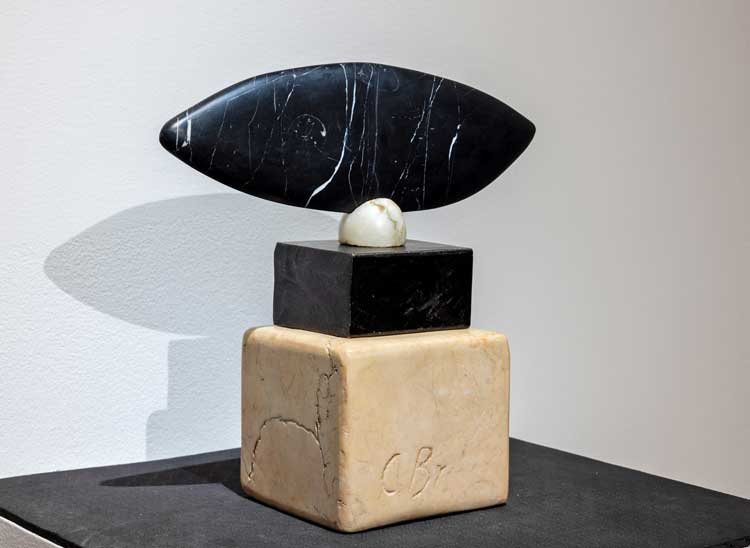
Constantin Brancusi, Fish (Le Poisson), c1920-22. Black-veined marble, 26.67 x 9.52 cm (10 x 3 in). Installation view, Expansive Change: Distortion as Dialogue in Modern & Contemporary Art, Leila Heller Gallery, New York, 2024. Photo: David Kaminsky.
The earliest works are a gouache of a reclining woman by the French cubist artist André Lhote from 1920 and a small, but elegantly assembled black-veined-marble fish by the Romanian sculptor Constantin Brâncuși, dated 1920-22. The most recent work is a painting by David Salle from 2013, Democratic Theory and Practice, its fractured, provocative juxtapositions corresponding to a disjunctive world. From the East Village artist Kenny Scharf there is OOZ (2000), its sleekly gloopy, coolly coloured forms doing just that. Scharf notably survived the 1980s, unlike many of his fellow downtown scenesters who tragically did not, among them Keith Haring, his friend (and roommate for a time), represented here by several works including one of his beloved Radiant Babies spraypainted on plywood.
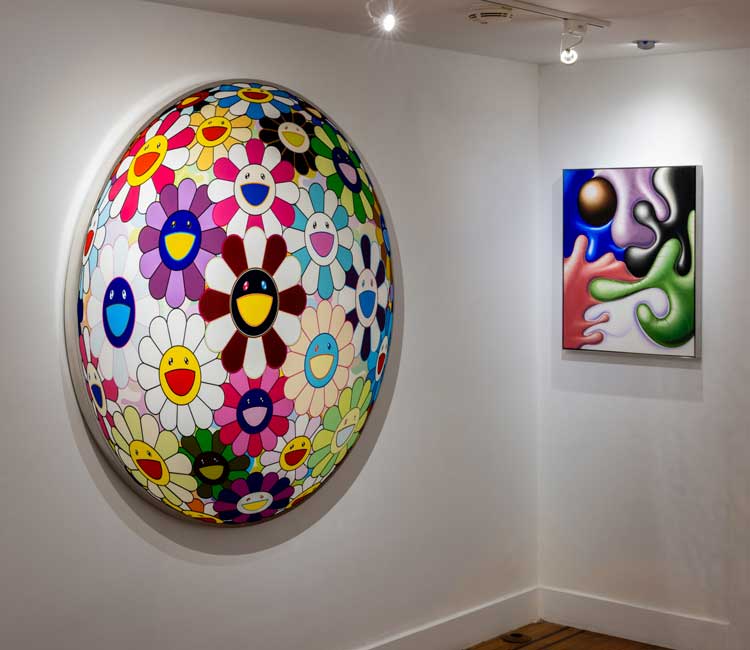
Left: Takashi Murakami, Flowerball Brown, 2008. Acrylic and platinum leaf on canvas
149.86 cm did (59 in dia); Right: Kenny Scharf, OOZ, 2000. Oil on canvas, 76.2 x 60.96 cm (30 x 24 in). Installation view, Expansive Change: Distortion as Dialogue in Modern & Contemporary Art, Leila Heller Gallery, New York, 2024. Photo: David Kaminsky.
The nearly three dozen works on view are hung closely together throughout the gallery’s spaces and give us an overview in between those dates from the curator’s elected vantage point. It was an era when change became not only normalised, abetted by these artists as well as the zeitgeist, but churned through at a head-spinning pace, as the next shiny new thing arrived, trumpeted by virtual and metaphoric exclamation points. This expectation of rapid turnovers was fuelled by a continuous succession of technological advances that profoundly affected all aspects of our lives: social, political, economic and psychological, with a corresponding impact on cultural production. The exhibition, for all that, focuses almost entirely on two-dimensional work (that stays refreshingly still), with Carl Andre’s late-1970s aluminium floor piece as a quiet but forceful nod to sculpture, in addition to the Brâncuși. The exhibition is not installed chronologically, and made me think of the French writer and cultural theorist André Malraux’s idea of an imagined museum where viewers could look at artworks next to each other from vastly separate epochs of time, made possible by the increasing sophistication of image reproduction that has led most recently to AI-generated images and who knows what else in the future?
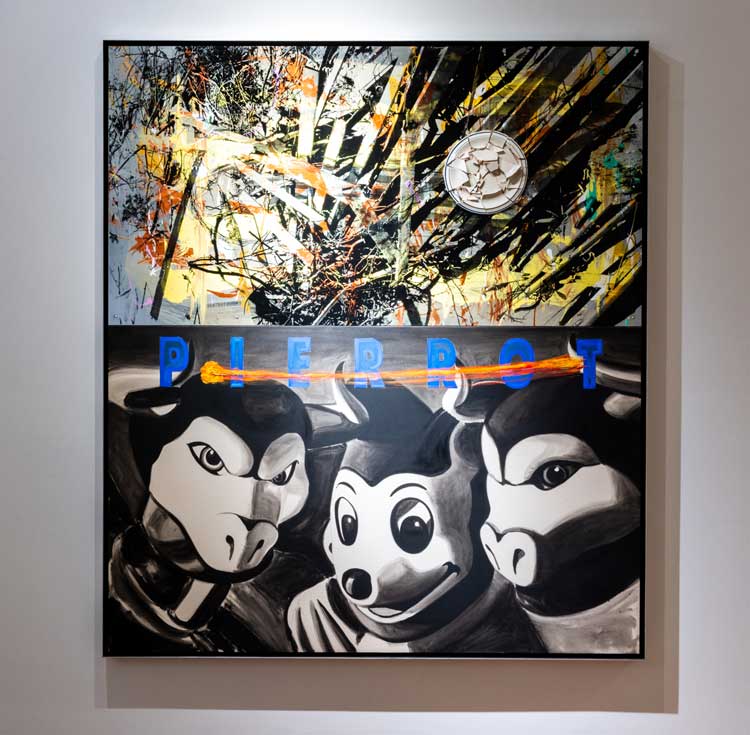
David Salle, Democratic Theory and Practice, 2013. Acrylic and silkscreen ink on metal, oil on canvas,
187.96 x 165.1 cm (74 x 65 in). Installation view, Expansive Change: Distortion as Dialogue in Modern & Contemporary Art, Leila Heller Gallery, New York, 2024. Photo: David Kaminsky.
The standout is Anselm Kiefer’s Melancholia (2005) and not only because it is the most monumental work in the show. Weighted with his signature mix of oil, acrylic and rust to create a landscape in tumultuous, apocalyptic upheaval, a transparent three-dimensional geometric form is affixed to its centre, as if to anchor it. Made of glass and iron and containing ash, iron and dried flowers, it summons up the idea of a reliquary, or perhaps an ark, a repository that salvages what it can from the wreckage, from the incessant cycles of life and death, the symbol of ends, but also of what might rise from the ruins.
Another moody, much smaller canvas is also patched and flecked with straw and echoes the tempestuousness of the Kiefer, but far less thunderously, less sweepingly. Called Autumno (1984), it is by the Iranian Armenian artist Marcos Grigorian, whose mixed media paintings nonetheless possess their own poignant, lingering timbres. The Cairene artist Wassef Boutros-Ghali, too, is not that familiar to audiences in New York. His Troy (2002), a painting of foreboding colours, bands, rectangles and flickered brushwork pictures a cityscape, as the title tells us, the formal language of geometric abstraction transformed into the pathos of another realm in tumult. The portal-like shape that occupies the foreground does double-duty as the Trojan horse that will also become a gateway into the besieged, barricaded city – and it’s no spoiler for most western viewers to say that it didn’t turn out well for those inside.
One more unfamiliar participant is the Mumbai architect and artist Jehangir Vazifdar whose eye-catching The Writer (mid-1970s) glows a burnished gold, the face abstracted along cubist principles and looking like a simple jigsaw puzzle that, on further viewing, challenges with its ambiguities. Is it just one face? Is it two? Is it in profile view or frontal? If multiple, is it a metaphor for the writer, the artist, as a person of many possible faces and personas – and a master of distortion?
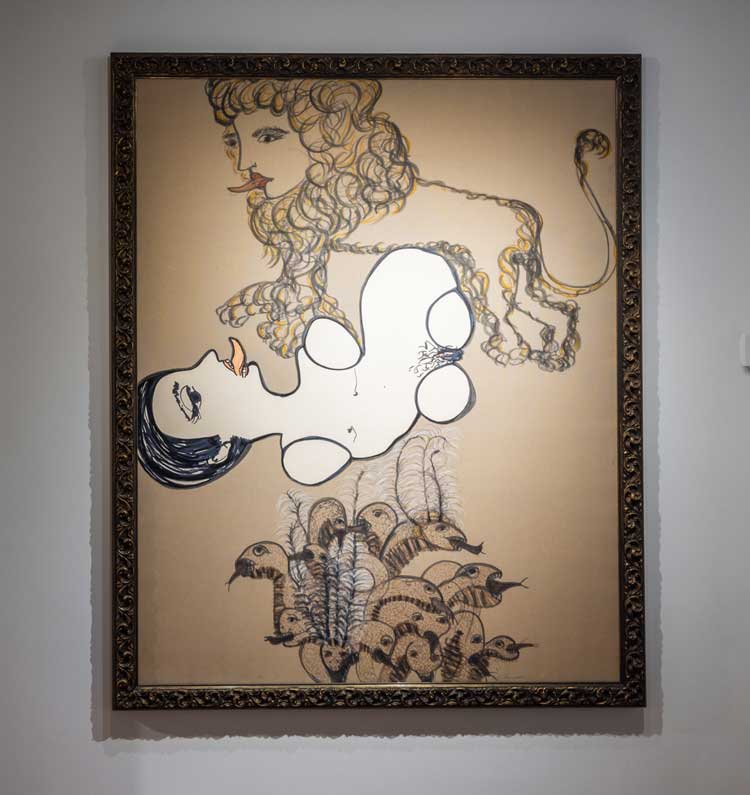
Carol Rama, Le Malelingue, 1980. Felt tip pen on acrylic and collage on a Capote canvas, 150 x 120 cm (59.06 x 47.25 in). Installation view, Expansive Change: Distortion as Dialogue in Modern & Contemporary Art, Leila Heller Gallery, New York, 2024. Photo: David Kaminsky.
We might also compare the image of Willem de Kooning’s witchy sketch of a woman on Mylar, all points and angles, her teeth sharp, her breasts raised to up around her neck, with Rama’s Le Malelingue (1980) to get two very different interpretations of women and their sexuality, one misogynistic, the other defiant, erotic, teasing.
One of the pleasures of exhibitions with large, encompassing themes is their looseness, their lack of confining dogmas. We can enjoy the works individually, revelling in the simple joy of their company, in which what we see is what we see, to paraphrase Frank Stella. And yes, there is a Stella here, although not a sculpture but an exuberantly hand-coloured collage with mixed media called Then Water Came and Quenched the Fire (1982-84), when he was en route to what would be an increasingly extravagant, instantly recognizable practice. It reminds us, as do other works here, that many of the giants of modernism and postmodernism have departed, some very recently. But it also reassures us that their art remains, for which we should be deeply grateful.